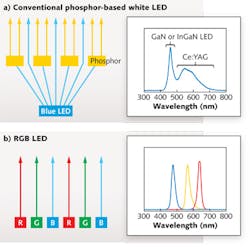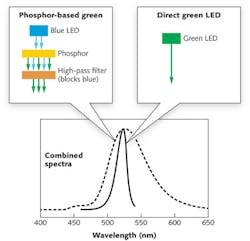PHOTONIC FRONTIERS: RGB LEDS FOR ILLUMINATION: Color-tunable RGB LED lighting goes far beyond replacement bulbs
The first generation of solid-state lighting is already replacing incandescent and fluorescent bulbs. Blue or violet light-emitting diodes (LEDs) excite yellow phosphors to produce white light far more efficiently than incandescent lamps and without the mercury and other limitations of fluorescents. The big challenges now are reducing LEDs' cost and cranking up their power to gain consumer acceptance.
But the real solid-state revolution in lighting is coming in the form of lamps that mix the outputs of red, green, and blue LEDs to give a broad range of colors. Some are already used for decorative lighting, and last year Philips Lighting (Amsterdam, The Netherlands) introduced color-tunable Hue bulbs that screw into home light sockets. Better yet, red-green-blue (RGB) LEDs can be good for you as well as fun because they can tune the shade of light to help you wake up in the morning, slip gently to sleep at night, and be more alert and productive during the day.
Approaches to white light
The first big quest in solid-state lighting was improving energy efficiency. That required a bulb that combined the pleasant color and ease of use of an incandescent with the high efficiency of a fluorescent, and could be used in existing fixtures. Developers met that goal by illuminating cerium-yttrium aluminum garnet (ce:YAG) phosphors with the bright blue emission of an indium-gallium-nitride LED. As shown in Fig. 2a, the blue light excited broadband emission from the green into the red from the phosphor. Adding a red phosphor or a separate red LED can shift the color balance toward the red, producing what the lighting industry calls "warm" light, although its color temperature actually is cooler.
Energy planners considered the alternative of combining red, green, and blue emitters, shown in Fig. 2b, but it was impractical. They worried that the need for three emitters would drive up costs and that each would age at different rates, so the color would change over time. They worried particularly about green LEDs, which were less efficient than red or blue, and were occupied on a part of the spectrum critical for color perception.RGB LEDs emerged anyway, but targeted different markets that wanted more control over color. Companies such as Philips Color Kinetics (Burlington, MA) and Osram Opto-Semiconductors (Regensburg, Germany) developed LED flood lamps that wash programmable palettes of shifting colors across the exteriors of buildings around the world. Arrays of LEDs brighten bridges from London to Da Nang, Vietnam, at modest cost. Artist Leo Villareal installed 25,000 LED nodes tunable to three shades of white on the western span of the San Francisco Oakland Bay Bridge to celebrate the bridge's 75th anniversary in 2011. Thanks to LED efficiency, the display needs only about $30 of electricity to power it for a night. And LED lifetimes of tens of thousands of hours slash the cost of replacing hard-to-reach burnt-out bulbs.
Shifting RGB LEDs between shades of white allows interior designers to change the moods of rooms. A restaurant may shift between a cool, bluish light for lunches and business meetings during the day, and a warmer, redder tone for evening relaxation. Boeing (Chicago, IL) picked tunable LED lighting for the interior of its 787 Dreamliner to save weight and energy, reduce maintenance, and to relax and refresh passengers. Children's Hospital Boston (Boston, MA) installed color-tunable LED lights in a ward where patients stay 5 to 6 weeks to recover from bone-marrow transplants. Simple color management "gives [patients] something they can control, and even very young children can use it," says program medical director Leslie Lehmann.
Philips made tunable RGB LEDs into high-tech toys by introducing its Hue bulbs last year through Apple (Cupertino, CA) stores, where they sell for $60 each or $200 for a set of three and a wireless controller. They screw into standard Edison sockets, and can be programmed through a smartphone or tablet. "Pricing aside, the Hue not only adds the convenience of wireless control, but it adds an element of wonder with its ability to easily recreate scenes and moods that were once confined solely to pictures. If I could afford it, I would replace every light bulb in my house with Hue bulbs," wrote reviewer Eugene Kim for PCMag.com.1
Lighting for health
The health connection comes from light's role in regulating our circadian rhythms. In 2001, researchers found that some retinal ganglion cells contain a pigment called melanopsin that responds strongly to blue light at 446 to 477 nm, blocking the release of sleep-inducing melatonin.2 That has led to the use of blue LEDs to treat seasonal affective disorder, and to broader research on how light affects sleep.
"Sleep deprivation is pervasive in modern industrial society," says George Brainard of Jefferson Medical College (Philadelphia, PA), who discovered the blue-light connection. "About 20 percent of the work force is doing shift work," many others hold two jobs, and artificial lighting is pervasive. Suppression of melatonin production by blue light is a leading suspect.
The diurnal cycle evolved to match natural changes in solar illumination during the day. Sunlight is reddish when the sun is low in the sky because scattering attenuates more blue light on its long path through the atmosphere. As the sun rises higher, more blue reaches the eye, shutting down melatonin production and making us more alert. As blue light drops toward evening, melatonin production increases to prepare for sleep. Disruption of this natural cycle can disrupt sleep.
That's a particular concern on the International Space Station, where the day is one 90-minute orbit, and inside illumination is blue-rich light from aging compact fluorescent bulbs. Astronauts are booked for eight hours a night of sleep, but half sleep less than six hours. Brainard has built a replica of the station's sleeping quarters in his lab to test if illumination with red-rich light can help people get a good night's sleep, and if blue-rich light can improve their alertness during the work day. The human vision system sees only a slight shade of difference in the white illumination, but the melanopsin recognizes the difference.
NASA wants to install new LED bulbs by 2015 because the current fluorescents are fading fast. They have yet to decide the exact configuration, but it may include one bank of phosphor-based fixed white LEDs and a second bank of tunable RGB LEDs to produce the desired shade of white. Brainard's lab uses similar arrays, which allow them to set thousands of color combinations. So far, the results are encouraging.3
Brainard envisions a future "smart lighting system" equipped with color-tunable lighting that would go far beyond the programmable mood-lighting approach of the Hue bulb or Boeing 787 to target people's health and well-being in home and office. You could set a default circadian rhythm for work days, or sensors might identify you and determine what lighting you want or need. The system might shift the lights in your toddler's playroom to reddish before naptime, or shift your dining room light to bluish when it sees you sitting there with a pile of papers and a laptop. It might do even more as we learn more about lighting, health, and human performance.
Quest for green LEDs
A key outstanding technical issue with RGB lighting is the need for better green LEDs. Gallium phosphide can emit at 540-580 nm, but its indirect bandgap limits performance. Today's leading contenders are blue InGaN LEDs exciting a green phosphor, and direct green InGaN LEDs. Each has their advocates.
Phosphor-based green LEDs include long-wave pass filters to block the blue LED pump band and now dominate the white RGB LED market. Their major advantages are a high luminous efficacy and a wide emission band, which is needed in illumination for good color rendering, says Young Rag Do of Kookmin University (Seoul, South Korea).4
His group is optimizing performance of tunable RGB LEDs using green-phosphor LEDs and hopes to commercialize it within two years. Using a series of green phosphors would allow color tuning.5 For applications such as signage and backlighting, where purer colors are needed for a wide color gamut, they are studying green phosphor LEDs with bandpass filters. Figure 3 compares the output of phosphor with that of a direct green LED.Direct green LEDs are commercially available, and don't suffer the down-conversion losses of about 30% in blue-LED pumped phosphors, but they are much less efficient than their blue counterparts. "State-of-the-art direct green LEDs have 20–25% external quantum efficiency, whereas blue is 50–60%," says Steve DenBaars of the University of California (Santa Barbara, California).6 "When direct green LEDs achieve 50% [efficiency], then RGB lighting will have better efficiency than blue plus a phosphor. It is very realistic, but needs a lot of research and development," he adds.
Outlook
Presently, direct emission green is not very efficient, so phosphor-converted green is better for RGB-based white illumination. However, once highly efficient direct-emission green becomes available, mixing several different narrowband wavelengths can produce white light with good color rendering properties and higher luminous efficacy. For now, RGB LEDs products are mostly used for full-color, dynamic-effect lighting. Depending on the technology and the application, tradeoffs will be involved in creating effective illumination, says Nadarajah Narendran of the Rensselaer Polytechnic Institute's Lighting Research Center (RPI; Troy, NY).
In any case, the real importance of tunable RGB LEDs is that they go beyond the original paradigm of simply replacing old, energy-wasting bulbs. Instead, they look "forward in time to envision or design light sources that have not been possible with conventional technology," says Fred Schubert of RPI.
REFERENCES
1. See http://www.pcmag.com/article2/0,2817,2417107,00.asp.
2. G. C. Brainard et al., J. Neurosci., 21, 16, 6405–6412 (August 15, 2001).
3. G. C. Brainard et al., Acta Astronaut., http://dx.doi.org/10.1016/j.actaastro.2012.04.019 (April 25, 2012).
4. J. H. Oh et al., Opt. Exp., 20, 18, 20276–20285 (2012).
5. J. H. Oh et al., Opt. Exp., 20, S1 (January 2, 2012).
6. Y. Zhao et al., Appl. Phys.Exp. V, 6, 062102 (2013).
About the Author
Jeff Hecht
Contributing Editor
Jeff Hecht is a regular contributing editor to Laser Focus World and has been covering the laser industry for 35 years. A prolific book author, Jeff's published works include “Understanding Fiber Optics,” “Understanding Lasers,” “The Laser Guidebook,” and “Beam Weapons: The Next Arms Race.” He also has written books on the histories of lasers and fiber optics, including “City of Light: The Story of Fiber Optics,” and “Beam: The Race to Make the Laser.” Find out more at jeffhecht.com.



